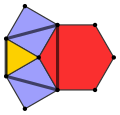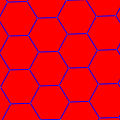Top Qs
Timeline
Chat
Perspective
Rhombitrihexagonal tiling
Semiregular tiling of the Euclidean plane From Wikipedia, the free encyclopedia
Remove ads
In geometry, the rhombitrihexagonal tiling is a semiregular tiling of the Euclidean plane. There are one triangle, two squares, and one hexagon on each vertex. It has Schläfli symbol of rr{3,6}.
| Rhombitrihexagonal tiling | |
|---|---|
 | |
| Type | Semiregular tiling |
| Vertex configuration |  3.4.6.4 |
| Schläfli symbol | rr{6,3} or |
| Wythoff symbol | 3 | 6 2 |
| Coxeter diagram | |
| Symmetry | p6m, [6,3], (*632) |
| Rotation symmetry | p6, [6,3]+, (632) |
| Bowers acronym | Rothat |
| Dual | Deltoidal trihexagonal tiling |
| Properties | Vertex-transitive |
John Conway calls it a rhombihexadeltille.[1] It can be considered a cantellated by Norman Johnson's terminology or an expanded hexagonal tiling by Alicia Boole Stott's operational language.
There are three regular and eight semiregular tilings in the plane.
Remove ads
Uniform colorings
There is only one uniform coloring in a rhombitrihexagonal tiling. (Naming the colors by indices around a vertex (3.4.6.4): 1232.)
With edge-colorings there is a half symmetry form (3*3) orbifold notation. The hexagons can be considered as truncated triangles, t{3} with two types of edges. It has Coxeter diagram ![]()
![]()
![]()
![]()
![]() , Schläfli symbol s2{3,6}. The bicolored square can be distorted into isosceles trapezoids. In the limit, where the rectangles degenerate into edges, a triangular tiling results, constructed as a snub triangular tiling,
, Schläfli symbol s2{3,6}. The bicolored square can be distorted into isosceles trapezoids. In the limit, where the rectangles degenerate into edges, a triangular tiling results, constructed as a snub triangular tiling, ![]()
![]()
![]()
![]()
![]() .
.
Remove ads
Examples
 From The Grammar of Ornament (1856) |
 The game Kensington |
 Floor tiling, Archeological Museum of Seville, Sevilla, Spain |
 The Temple of Diana in Nîmes, France |
 Roman floor mosaic in Castel di Guido |
Related tilings
Summarize
Perspective

There is one related 2-uniform tiling, having hexagons dissected into six triangles.[2][3] The rhombitrihexagonal tiling is also related to the truncated trihexagonal tiling by replacing some of the hexagons and surrounding squares and triangles with dodecagons:
Circle packing
The rhombitrihexagonal tiling can be used as a circle packing, placing equal diameter circles at the center of every point. Every circle is in contact with four other circles in the packing (kissing number).[4] The translational lattice domain (red rhombus) contains six distinct circles.
Wythoff construction
There are eight uniform tilings that can be based from the regular hexagonal tiling (or the dual triangular tiling).
Drawing the tiles colored as red on the original faces, yellow at the original vertices, and blue along the original edges, there are eight forms, seven topologically distinct. (The truncated triangular tiling is topologically identical to the hexagonal tiling.)
Symmetry mutations
This tiling is topologically related as a part of sequence of cantellated polyhedra with vertex figure (3.4.n.4), and continues as tilings of the hyperbolic plane. These vertex-transitive figures have (*n32) reflectional symmetry.
Deltoidal trihexagonal tiling

The deltoidal trihexagonal tiling is a dual of the semiregular tiling known as the rhombitrihexagonal tiling. Conway called it a tetrille.[1] The edges of this tiling can be formed by the intersection overlay of the regular triangular tiling and a hexagonal tiling. Each kite face of this tiling has angles 120°, 90°, 60° and 90°. It is one of only eight tilings of the plane in which every edge lies on a line of symmetry of the tiling.[5]
The deltoidal trihexagonal tiling is a dual of the semiregular tiling rhombitrihexagonal tiling.[6] Its faces are deltoids or kites.
Related polyhedra and tilings
It is one of seven dual uniform tilings in hexagonal symmetry, including the regular duals.
This tiling has face transitive variations, that can distort the kites into bilateral trapezoids or more general quadrilaterals. Ignoring the face colors below, the fully symmetry is p6m, and the lower symmetry is p31m with three mirrors meeting at a point, and threefold rotation points.[7]
This tiling is related to the trihexagonal tiling by dividing the triangles and hexagons into central triangles and merging neighboring triangles into kites.
The deltoidal trihexagonal tiling is a part of a set of uniform dual tilings, corresponding to the dual of the rhombitrihexagonal tiling.
Symmetry mutations
This tiling is topologically related as a part of sequence of tilings with face configurations V3.4.n.4, and continues as tilings of the hyperbolic plane. These face-transitive figures have (*n32) reflectional symmetry.
Other deltoidal (kite) tiling
Other deltoidal tilings are possible.
Point symmetry allows the plane to be filled by growing kites, with the topology as a square tiling, V4.4.4.4, and can be created by crossing string of a dream catcher. Below is an example with dihedral hexagonal symmetry.
Another face transitive tiling with kite faces, also a topological variation of a square tiling and with face configuration V4.4.4.4. It is also vertex transitive, with every vertex containing all orientations of the kite face.
Remove ads
See also
Wikimedia Commons has media related to Uniform tiling 3-4-6-4 (rhombitrihexagonal tiling).
Notes
References
Wikiwand - on
Seamless Wikipedia browsing. On steroids.
Remove ads

































































